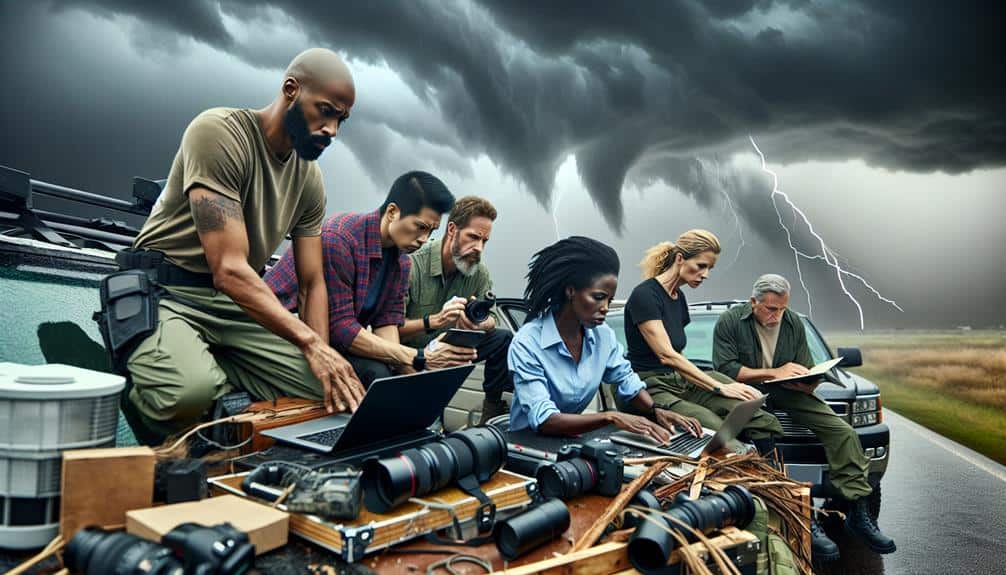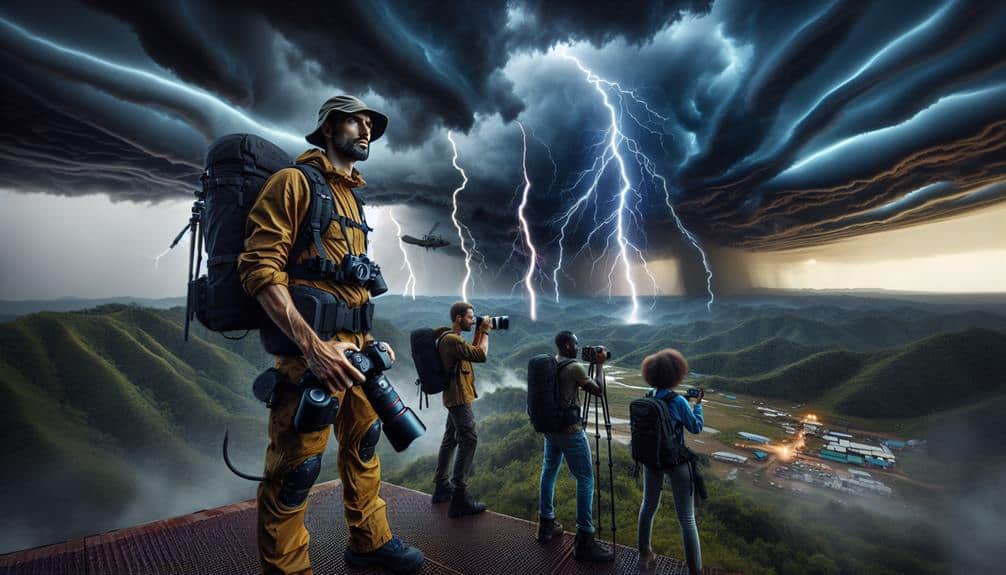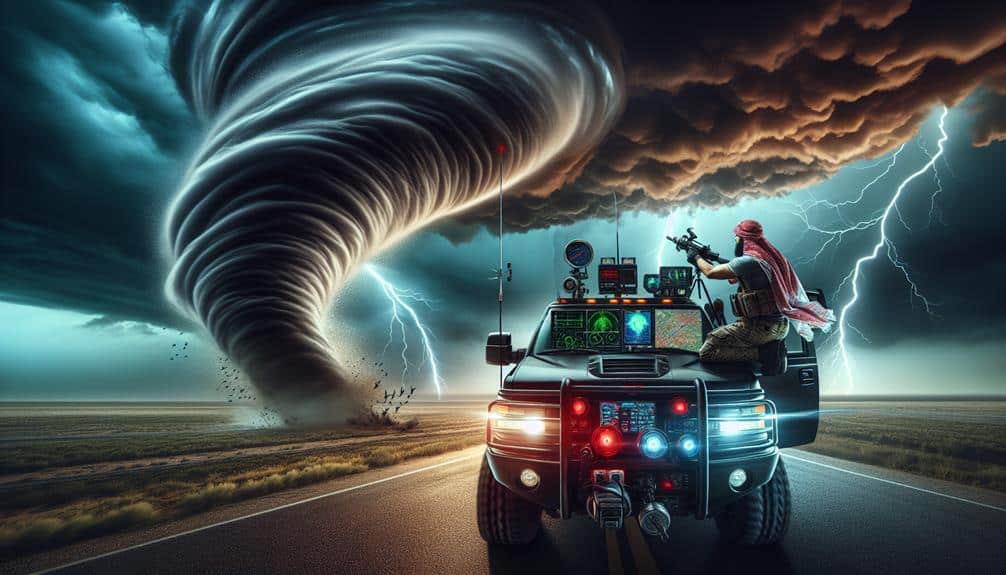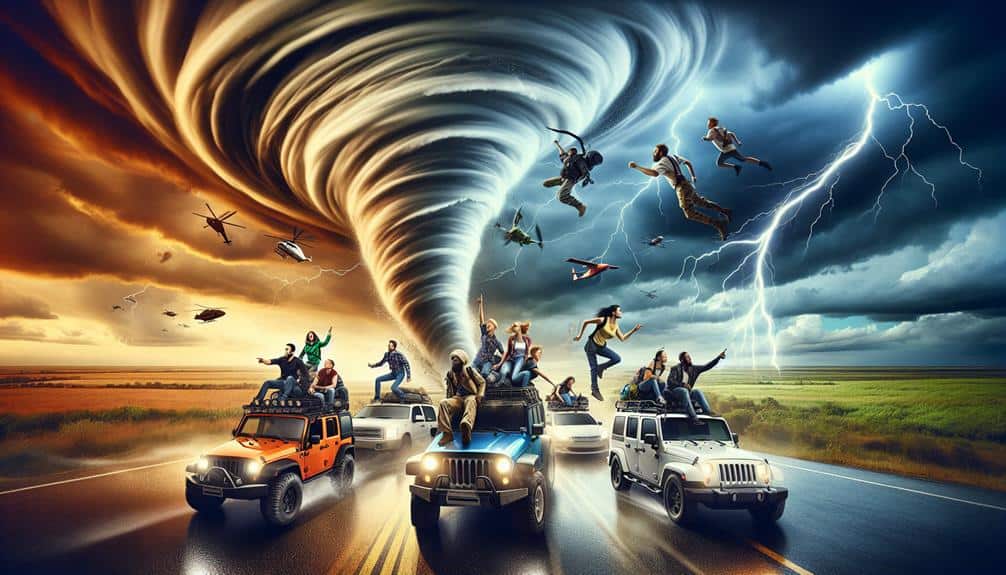We prioritize extensive safety protocols to protect storm chasers during severe weather events. We rely on advanced tools like Doppler radar and numerical weather prediction models for tracking and analyzing storm patterns. Necessary safety gear includes waterproof, wind-resistant clothing, protective eyewear, and durable non-slip boots. Reliable communication strategies utilizing radio systems and real-time weather apps are essential. Emergency response plans include predefined evacuation routes through GIS mapping and real-time data feeds. Post-chase, we assess equipment integrity and conduct debriefings to improve future operations. For a detailed breakdown of each protocol, we have compiled detailed guidelines.
Key Points
- Equip team members with waterproof, wind-resistant clothing, durable boots, and UV-protective eyewear.
- Utilize real-time weather apps and reliable radio systems for effective communication.
- Establish and rehearse predefined emergency evacuation routes and shelter locations.
- Conduct regular check-ins and assign specific roles to enhance team coordination.
Understanding Weather Patterns
To guarantee accurate storm chasing, we must analyze synoptic weather patterns and mesoscale meteorological data. By doing so, we can enhance our weather forecasting accuracy and improve our storm tracking capabilities.
Synoptic weather patterns provide a broad overview of atmospheric conditions across large areas, allowing us to identify significant features such as high and low-pressure systems, frontal boundaries, and jet streams. This information is essential for predicting severe weather events.
Mesoscale meteorology, on the other hand, focuses on smaller-scale phenomena, typically spanning from a few kilometers to several hundred kilometers. These include thunderstorms, tornadoes, and other convective events.
To accurately track these mesoscale features, we use advanced tools such as Doppler radar, satellite imagery, and numerical weather prediction models. These technologies provide us with real-time data on storm development, movement, and intensity.
Essential Safety Gear
Equipping ourselves with essential safety gear is vital to guarantee our well-being while chasing storms. By investing in proper clothing, we reduce the risk of exposure to severe weather conditions. Waterproof, wind-resistant jackets and pants are non-negotiable to secure our protection from rain and wind. Additionally, thermal layers are necessary for maintaining ideal body temperature in colder environments.
Protective eyewear is indispensable when traversing through high-velocity winds that may carry debris. High-impact polycarbonate lenses provide strong protection against flying objects, while UV protection shields our eyes from harmful solar radiation. Prescription-strength safety glasses are available for those needing vision correction.
Footwear is another crucial component. Durable, water-resistant boots with non-slip soles prevent injuries on wet or uneven terrain. Furthermore, a high-quality helmet with integrated communication capabilities serves dual purposes: safeguarding our head from impact and enabling hands-free communication.
Carrying a well-equipped first aid kit is vital for addressing minor injuries promptly. Items such as adhesive bandages, antiseptic wipes, and gauze pads should be included.
Lastly, a durable backpack with multiple compartments allows us to organize and access our gear efficiently, ensuring we remain flexible and prepared for any situation.
Communication Strategies
Effective communication strategies are necessary for storm chasers to coordinate actions and guarantee safety in rapidly changing weather conditions. By leveraging precise terminology and data-driven tools, we can ensure best team coordination and timely weather updates.
To achieve seamless communication, we recommend:
- Utilizing reliable radio systems: High-frequency radios with a range of at least 5 miles guarantee we maintain contact despite potential signal loss in remote areas.
- Deploying real-time weather monitoring apps: Apps like RadarScope provide us with up-to-the-minute weather updates, enhancing our situational awareness and decision-making capabilities.
We prioritize team coordination by assigning specific roles, such as a designated communicator who monitors weather updates and relays important information. Additionally, regular check-ins at set intervals ensure everyone remains informed and aligned with the evolving conditions.
In our experience, effective communication isn't just about the tools we use but also about our commitment to clarity and consistency. By adhering to these strategies, we maximize our operational efficiency and maintain the freedom to make informed, agile decisions in the face of unpredictable weather phenomena.
Emergency Response Plans
In developing our emergency response plans, we prioritize swift mobilization and resource allocation to mitigate risks during severe weather events. First, we identify best evacuation routes through GIS mapping, guaranteeing they remain clear and accessible. By continuously updating our route data, we account for road closures, traffic patterns, and potential hazards. This allows us to navigate efficiently and avoid bottlenecks that could delay safe egress.
Next, we determine shelter locations based on structural integrity and proximity to our primary chase areas. We evaluate these shelters using criteria such as wind resistance, accessibility, and capacity. Our team regularly inspects these locations to make sure they meet safety standards and are equipped with essential supplies. We also establish secondary shelters in case primary options become compromised.
Communication protocols are integral to our plans. We utilize real-time data feeds and satellite communication to relay critical information to all team members. This guarantees everyone is aware of the current situation and can respond swiftly. Additionally, we conduct periodic drills to simulate emergency scenarios, refining our response strategies.
Post-Chase Procedures

After confirming our emergency response plans are robust, we shift our focus to thorough post-chase procedures to analyze data, assess equipment integrity, and debrief team members.
Post-chase, our primary objective is to conduct a detailed assessment to enhance future operations and safeguard the well-being of our team.
First, we prioritize data collection. We systematically compile meteorological data, visual recordings, and sensor readouts, ensuring accuracy and completeness. This data is essential for advancing our understanding of storm behaviors and refining our predictive models.
Next, we assess equipment integrity. Every piece of gear, from anemometers to communication systems, is inspected for any damage or wear. This guarantees that all apparatuses are operational for subsequent chases, minimizing the risk of equipment failure in critical situations.
Finally, we hold debriefing sessions to discuss the chase. These meetings are crucial for addressing any issues encountered, evaluating team coordination, and fostering continuous improvement. Additionally, we emphasize the mental health of our team members, recognizing the high stress involved in storm chasing.
- Data collection: Ensure all meteorological and visual data is accurately compiled.
- Equipment assessment: Inspect and maintain all gear for future use.
This structured approach guarantees we're prepared and resilient for the next storm chase.
Frequently Asked Questions
What Is the Best Time of Year to Chase Storms?
The best time to chase storms is spring due to pronounced seasonal trends. Ideal locations include Tornado Alley. Prioritize safety precautions and necessary gear, such as weather radios and GPS systems, to enhance our storm-chasing experience.
How Can I Find a Reliable Storm Chasing Tour Guide?
To find a reliable storm chasing tour guide, we should evaluate their safety measures, equipment, tour guide qualifications, and experience. Reviewing customer testimonials and industry certifications provides data-driven insights, ensuring we make an informed, freedom-enhancing decision.
Are There Specific Regions More Prone to Severe Storms?
Storm activity patterns paint the sky with chaos in Tornado Alley, the Gulf Coast, and the Midwest. These regions' geographic vulnerability to severe storms stems from unique atmospheric dynamics and topographical features. Let's chase the thrill responsibly!
What Kind of Vehicle Is Best for Storm Chasing?
We've found that a modified SUV or truck excels in vehicle safety for storm chasing. It should include an equipment checklist with reinforced windows, GPS, radar, and emergency supplies to guarantee both safety and operational efficiency.
How Do I Get Involved With Storm Chasing as a Beginner?
To get involved with storm chasing, we should start by learning safety tips and acquiring essential equipment needed, like GPS, weather tracking software, and communication tools. Training with experienced chasers guarantees our comprehension of the risks and protocols.


